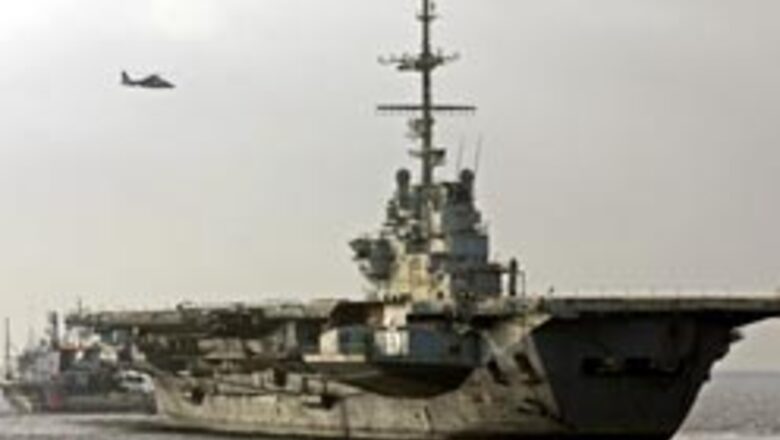
views
Bangkok: After it slid down the gangway in 1960, the S S France became one of the last great liners in the heyday of trans-Atlantic cruise ships, carrying the likes of artist Salvador Dali and his pet ocelot, and taking the Mona Lisa to an exhibition in the United States.
Today it's headed to a scrap yard at Alang in western India, raising protests from Greenpeace and other NGOs which contends it contains more than 1,000 tons of asbestos and other toxic materials.
The France was one of the fastest and longest passenger ships - stretching 315 meters - so long it couldn't fit into the locks of the Panama Canal.
Its avant-garde design, winding staircase, tuxedo-clad diners and fine cuisine came to symbolise luxury on the high seas.
The wife of French President Charles de Gaulle christened the France. After its maiden voyage in 1962, it traveled between Europe and New York nearly 400 times until the mid-1970s.
"Everything goes back to her history. She was definitely a trend setter," said Allan Jordan, a maritime historian who once sailed on the vessel. "There were only a handful of ships that could give her competition. At this point, there are very few of them left."
But much to the dismay of those who loved the France , the ship will face the same fate that befalls hundreds of rusted oil tankers, cargo ships and ferries every year.
And the liner's toxic materials are likely to revive debates in India and abroad about the dangers of breaking down ships in developing countries.
Just three months ago, the French government was forced to recall the asbestos-carrying Clemenceau, a decommissioned French aircraft carrier also bound for Alang.
The French government initially said it contained 45 tons of asbestos but environmentalists said their studies found as much as 1,000 tons.
Fans for years mounted a campaign to save the vessel, perhaps as a floating hotel, casino or hospital, but they just ran out of time.
The ship never had it easy. It entered service just as jet airliners started to become the primary mode of crossing the Atlantic.
With a sleek hull reminiscent of the famed SS Normandie, the France made headlines with two round-the-world trips. But it needed subsidies to stay in business, and the French government cut off the aid in 1974.
Its owner, Compagnie General Transatlantique, retired the ship later that year.
It was sold to an Arab sheik who talked of opening a floating museum before Norwegian Cruise Lines bought the liner in 1979.
The company rechristened it the SS Norway and spent nearly US$80 million converting it into a pleasure cruise ship with outdoor swimming pools and sun decks.
PAGE_BREAK
For two decades, the ship took 2,000 passengers at a time on weekly trips in the Caribbean.
In 2000, the liner acquired yet another owner, Hong Kong-listed Star Cruises. It got a new name last year - Blue Lady - but it hasn't carried any passengers since a boiler explosion killed eight crewmen in 2003 and repairs proved too costly to keep it in service.
Rumors of the ship's demise first surfaced last year, when Bangladeshi media reported that Star Cruises was planning to sell the ship to a Bangladeshi ship breaker for $13 million.
A spokeswoman for Star Cruises, who refused to be identified, confirmed that the ship had been sold, but said she was not allowed to disclose either the buyer or the purchase price. She refused to provide any additional details.
The Bangladeshi government ruled in February that the liner couldn't be broken up in that country until it is decontaminated.
Greenpeace and other environmental groups contend the ship contains 1,250 tons of asbestos and other toxic materials.
Bangladesh's decision seemed to offer a glimmer of hope for the ship's fans, some of whom made up to 50 trips on the liner, others who met their spouses on board or made their first voyage on the majestic ship.
Supporters in recent years have set up Web sites devoted to saving the France. They even unsuccessfully petitioned the US Congress for help.
"Sadly, there are so many things stacked against her at the moment that there is little hope for a future where she can be at sea where she belongs," said Devon Scott, the ship's former historian who headed the Norway Preservation Foundation in hopes of saving the ship.
Port officials in Malaysia confirmed Tuesday the ship had pulled anchor Monday and was being towed to the Indian Ocean by two tug boats.
Shipping agents in the Alang in India's Gujarat state - where most of the ship breaking is done - said they had also heard the ship was heading to the port but could not say when it might arrive.
Greenpeace - which has led a campaign to clean up the ship breaking industry in India - said it has written a letter to Ministry of Environment and Forests, but so far there has been no response from the government.
"We have a general concern that there are toxic substances on board and that workers would be exposed to these substances," said Eco Matser, a representative of Greenpeace. "The ship should be decontaminated before it is sent to Asia."

















Comments
0 comment